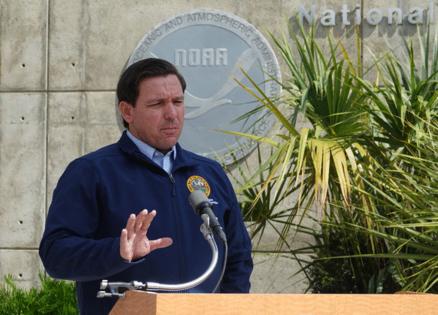Florida Gov. Ron DeSantis says tornado deaths tragic, but Hurricane Milton toll could have been worse
Published in News & Features
ORLANDO, Fla. — Gov. Ron DeSantis said Thursday that while Hurricane Milton has been destructive, it could have been a lot worse, as the state focused efforts on recovery hours after the storm moved away from the state.
He spoke from the St. Lucie County Sheriff’s Office in Fort Pierce, which was among the damaged structures amid a spate of tornadoes in the county that killed at least five people.
“We are very, very saddened to see a tornado inflict such serious damage, including loss of life,” DeSantis said. “These are things that are very, very tough to withstand. You don’t get a lot of warning on them, and they’re very, very devastating. And tragically, to lose five really, really is tough for this community. So our hearts go out to everybody who’s been affected by this, and we’re happy to have been supportive of the rescue efforts and will continue to be supportive going forward.”
He said port damage was being assessed, and that east coast ports and the Port of Tampa seem to be OK, but the port in Manatee County damage remains to be seen.
“Bottom line is, we got to get keep bringing fuel into this state,” he said.
He said there is still 1.5 million gallons of diesel on hand and 1.1 million pounds of gasoline that can be deployed with Florida Highway Patrol escorting fuel tankers, something the state has already done about 130 times, DeSantis said.
“Probably going to be OK on the east coast of Florida, some of the places in the Tampa Bay area, when there was evacuation, everyone was going to get gas, and some people were filling up additional tanks in addition to what was in their car with with a gallon containers or whatever they have, which is fine, but just the demand was went through the roof, and so these guys ran out,” he said. “My hope is that there’s minimal interruption with fuel on the backside of the storm.”
Florida Division of Emergency Management Director Kevin Guthrie addressed the first-response effort when the tornadoes were blowing through the state.
“The strength of what happened here is organically, our state mutual-aid system. The very first group that was on hand here was a Palm Beach County Fire Rescue search and rescue team,” he said. That was followed by task forces from Miami Dade, Ohio and Virginia. “That’s just a strength of not just the State Emergency Response Team, the state emergency response plan, but also outside states, helping states.”
DeSantis said St. Lucie County had the most damage from what he’s seen among more than 120 tornado warnings statewide.
St. Lucie County Sheriff Keith Pearson said the response is still a search and rescue mission, during which responders recently found a fifth victim after announcing four victims initially.
“Our rescue team is still out there. This is a rescue mission. We’re sifting through the debris … We’re going to continue through this,” he said.
The initial response was from Florida National Guard soldiers deployed by DeSantis.
“This was during the storm. He sent down the National Guard. So while we’re all hunkering down trying to stay safe, these men and women are driving through the storm to get here, and they work throughout the night, and their actions 100% saved lives, saved our lives,” he said.
DeSantis said for now, other than the five tornado-related deaths, no other confirmed hurricane-related deaths have been reported.
“Unfortunately, we have the fatalities from this tornado here. We don’t have confirmed reports of other fatalities throughout the rest of the state, but we may,” he said.
Addressing the storm’s historical impact, DeSantis thinks there were maybe 27 hurricanes that had lower barometric pressure than Milton, and of those 17 occurred prior to 1960, with the most powerful being the Labor Day hurricane of the 1930s.
“It totally wiped out the Keys. We’ve never seen anything like it, and that remains head and shoulders above any powerful hurricane that we’ve ever had in the state of Florida,” he said.
The most deadly the Okeechobee hurricane of 1928 that killed more than 4,000 people, he said.
“Fortunately, we aren’t going to have anything close to that on this hurricane, but even ones like Ian, where you had, wasn’t even close to that,” he said. “So I just think people should put this in perspective there.”
That said, he was still mindful of the loss of life, especially for an event that could not have been prevented, he said.
“It’s a tragic thing, because it’s not like, oh, they should have. What do you do when you have a tornado? You kind of duck and cover. Happens so quickly. Those things are really, really strong and powerful,” he said.
U.S. Rep. Brian Mast was on site and praised DeSantis for the state’s lead with federal assistance.
“Governor’s done a fantastic job just being an air traffic control tower for all of this, making sure the old saying, an ounce of prevention is worth a pound of cure,” he said. “From the governor’s office to the sheriff’s departments across the state, state representatives, state senators, Florida Highway Patrol, National Guard, FDLE, Florida, Power and Light, everybody made sure they can do every ounce of prevention.”
Earlier, he spoke from the State Emergency Operations Center in Tallahassee, and he has a planned update from Sarasota at 2:45 p.m.
Despite the potential that more deaths could be added to Milton’s toll, DeSantis’ initial assessment was the state dodged a bullet, partly because many people evacuated from the storm-surge threatened area.
“We had certain worst-case scenarios in terms of going into Tampa Bay, a lot of places in Pinellas County, and they had negative storm surge because it sucked the water out of the bay. So in terms of all that, where you’d see the entire Tampa Bay Area underwater, that did not happen,” he said.
The highest surge areas were in Sarasota County, which hit 8-10 feet, whereas Hurricane Helen saw up to 20 feet in Taylor County.
DeSantis said outside reports the state may be facing $50 billion in damage was not reasonable.
“I’m not saying there’s not going to be damage. There will be a cut across the state, in a way that Helene did not, but in terms of just right now, the morning after, if I think back to like Hurricane Ian, I don’t think that you’re looking at similar amount of damage to Ian,” he said.
Part of major damage would be because of the foreboding storm surge that had been facing Tampa Bay, which ended up not happening. In the end, parts of the coast saw similar or less surge than was seen two weeks earlier with Hurricane Helen.
“There may end up being more overall damage there. May not, I don’t know, but definitely the surge did not reach Helene levels. I mean, Helene was producing major surge all across the west coast of Florida, and then in the Big Bend, it was just a biblical,” he said.
He said the focus now is to get roads clear, bridges reopened and people back to their homes.
“We had over 80,000 people that were into shelters overnight as the storm hit the state,” he said. “We will better understand the extent of the damage as the day progresses.”
Teams are out in force to assess damage.
“What we can say is the storm was significant, but thankfully, this was not the worst case scenario,” he said. “The storm did weaken before landfall, and the storm surge, as initially reported, has not been as significant overall as what was observed for Hurricane Helene.”
First responders continue work that began overnight to help people in distress.
“State search and rescue teams report at least 48 individuals have been rescued as of 6:30,” he said. “National Guard search and rescue teams have worked overnight and successfully executed rescues of families and pets on the West Coast and from the destruction of the tornadoes in east, in the central and eastern parts of Florida.”
He said the National Guard continues Thursday morning amid 125 active missions in 26 different counties with more than 6,500 soldiers deployed.
Florida Fish and Wildlife Commission made land and water rescues in Pinellas, Hillsborough and Pasco counties, he said, while the Florida State Guard has also helped with search and rescue, floodwater evacuations and damage assessments.
Hurricane Milton made landfall on Siesta Key on the Florida Gulf Coast on Wednesday night as a major Category 3 hurricane with 120 mph winds as the state endured an assault of at least 19 tornadoes that resulted in multiple deaths. It never lost hurricane strength as it crossed the state exiting near Cape Canaveral by 4 a.m. Thursday.
As of 8 a.m., the hurricane was located about 75 miles east-northeast of Cape Canaveral with maximum sustained winds of 85 mph. moving northeast at 18 mph. Its eye had moved off the coast as of 4 a.m. after spending nearly seven hours crossing the state.
More than 3.3 million customers without power in the state as of 8:30 a.m., according to poweroutage.us. DeSantis said 635,000 customers had already had their power restored.
More than 50,000 linemen are staged in Florida to deploy and tackle the outages. The hardest hit counties were Hillsborough (75%), Hardee (97%), Manatee (82%), Pinellas (68%) and Sarasota (75%).
Guthrie urged Florida residents to not go out and visit the damaged areas.
“You will be inhibiting first responders by doing so. By now, we need those roadways cleared for electrical crews, fire crews, EMS crews, urban search and rescue crews,” he said.
Emergency officials across the state urged residents to stay inside as teams assessed damage including downed power lines and fallen trees. Search and rescue operations were in effect in some Gulf Coast counties.
He said 20 such crews will move into impacted areas and do door-by-door searches.
“This was not the worst-case scenario. We still had damage, and we’re going to need to get out there and go door to door and make sure that everyone is OK so please stay off the road,” he said.
While the governor’s executive order called out local governments so they would not be able to block people trying to get back to their homes, Guthrie said be patient.
“I know a lot of people evacuated, and we appreciate that,” he said. “Do not be in a hurry. Check in with your local emergency management agency or local sheriff’s offices to see if they’re posting anything on if it’s safe to return home.”
The state will be opening up roads and bridges, but residents need to check first before heading home.
“There may be extenuating circumstances in the neighborhood level. So please make sure you’re checking before you come back home,” he said.
He said flooding from the major rain that came across the state continues to be a problem on the Hillsborough, St. Johns and Little Wekiva rivers.
“There is going to be another phase to this particular incident, and that is very similar to Hurricane Ian,” he said. “We have a lot of rain that has fallen over the central portion of Florida, the St. Johns River basin that comes down into Seminole County, Brevard, portions of Brevard, portions of Volusia County, and on up the St Johns River, those headwaters have experienced a lot of rainfall.”
He said that river takes 45 days to completely flush itself out to the Atlantic, so impacts will begin in Seminole County and move up into Volusia, St. Johns, Flagler, Clay and Duvall counties.
“So that’s going to be a long-term effort,” he said.
Several roadways remain flooded, and Guthrie urged people to not walk or drive through floodwaters.
He asked people to take photos of damages to their home inside and outside.
“Make sure you’re documenting just the physical damages, but then also, since this was a flooding event, we want to make sure that you capture those, what we call high water marks on your home. Do that inside and outside,” he said.
For cleanup, he urged residents to wear appropriate safety gear.
“Do not attempt to clean up hazardous debris or downed power lines,” he said. “”Report all of that to your local authorities. Do not cut any lines again. We do not need Florida man and Florida woman out there cutting random lines as they go. You don’t know what is a cable line. You don’t know what is a electrical line, and probably more importantly these days is you don’t know what is a fiberoptic line. Most of our 911 lines run across fiberoptic we do not want anybody cutting lines. Let the professionals come in here and identify what it is before it’s cut.”
The state assistance information line is 1-800-342-3557.
©2024 Orlando Sentinel. Visit at orlandosentinel.com. Distributed by Tribune Content Agency, LLC.







Comments